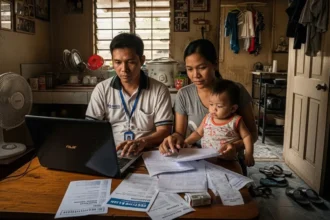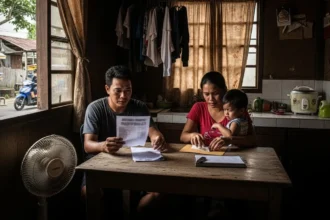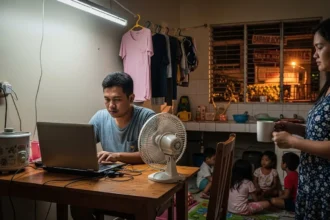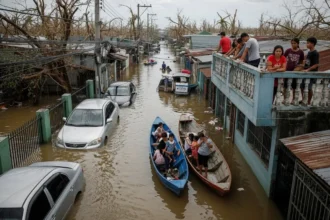When it comes to saving money in the Philippines, the choice of bank matters just as much as the habit of saving itself. With inflation pushing the cost of living higher and digital banking reshaping the way Filipinos handle money, finding the best savings banks in 2025 has become a crucial step for financial security.
- 🏦 Traditional Banks: Tried and Tested
- 📲 Digital Banks: The Game Changers
- 📊 Table 1: Comparison of Traditional vs. Digital Savings Accounts (2025)
- 🌟 Best Savings Banks in 2025 (Philippines)
- BDO Unibank
- Bank of the Philippine Islands (BPI)
- Metrobank
- Land Bank of the Philippines (LANDBANK)
- 📦 Table 2: Best Banks for Different Types of Savers (2025)
- 💡Tips to Maximize Your Savings in 2025
- Frequently Asked Questions about Best Banks for Savings in the Philippines 2025
- ✨ The Future of Saving in the Philippines
- 🏦 References
Many Filipinos still rely on traditional banks, drawn by their reputation and stability. But over the past few years, digital banks have entered the scene, offering interest rates up to 6% per year compared to the 0.25% or 0.5% from traditional institutions. This shift has forced even established banks to innovate, creating a competitive environment that benefits savers.
The question for most is no longer “Should I save?” but “Where should I save?”. The answer depends on your goals. Do you want easy access to your money? Do you prioritize the highest interest rates? Or do you prefer the security of long-established banks backed by decades of trust? Each choice carries pros and cons, and in 2025, the options are more diverse than ever.
This article will guide you through the best banks in the Philippines for savings in 2025 – from traditional banks that provide unmatched reliability to digital-first institutions revolutionizing how Filipinos save and grow their money.
🏦 Traditional Banks: Tried and Tested
Despite the rise of digital banks, traditional institutions like BDO, BPI, Metrobank, and Landbank remain popular. They may not offer the highest interest rates, but they provide peace of mind through a vast branch and ATM network, strong customer service, and government guarantees via the Philippine Deposit Insurance Corporation (PDIC).
Why Choose a Traditional Bank?
- Security: Time-tested and highly regulated.
- Accessibility: Thousands of branches and ATMs nationwide.
- Trust: Recognized names with established reputations.
For many Filipinos, especially older generations, the reliability of traditional banks outweighs the appeal of high-interest rates. These banks also offer perks such as bundled services – credit cards, loans, and investment accounts all under one roof.
📲 Digital Banks: The Game Changers
In 2025, digital banks dominate conversations about savings. Platforms like SeaBank, Maya Bank, Tonik, and GCash GSave offer 5–6% annual interest rates, dwarfing traditional banks. With easy account opening (often requiring only one valid ID and a smartphone), they’ve become the go-to option for millennials, Gen Z, and tech-savvy professionals.
Advantages of Digital Banks
- High Interest Rates: Up to 20x more than traditional banks.
- Convenience: Open accounts in minutes through apps.
- Low Minimum Deposit: Sometimes no deposit requirement at all.
- Lock-in Features: Force discipline by restricting withdrawals.
Still, concerns remain about customer support, lack of physical presence, and system downtimes. Yet for many savers, the tradeoff is worth the growth potential of their money.
📊 Table 1: Comparison of Traditional vs. Digital Savings Accounts (2025)
| Bank Type | Average Interest Rate | Accessibility | Minimum Deposit | Trust Factor |
|---|---|---|---|---|
| Traditional Bank | 0.25% – 0.5% | High (branches, ATMs) | ₱2,000 – ₱10,000 | Very High |
| Digital Bank | 4% – 6% | App-based only | ₱0 – ₱1,000 | Moderate |
🌟 Best Savings Banks in 2025 (Philippines)
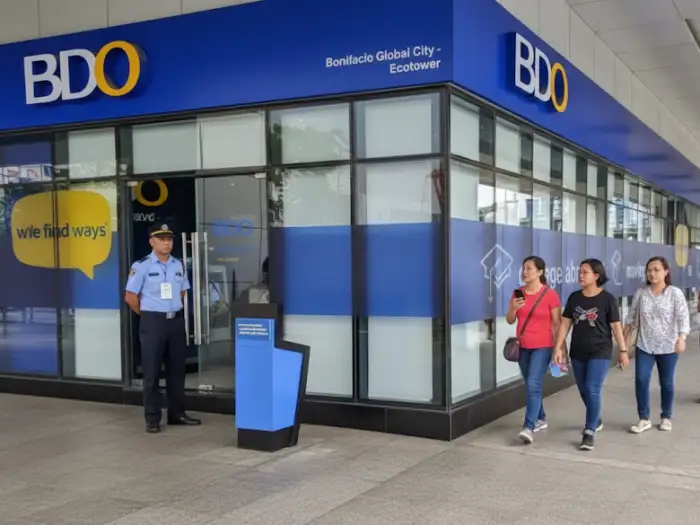
BDO Unibank
As the largest bank in the Philippines, BDO Unibank has built a reputation on accessibility and comprehensive service. With the most extensive network of branches and ATMs across the archipelago, you are almost always near a BDO point of service. Its slogan, “We Find Ways,” resonates with clients who need a one-stop shop for everything – from basic savings accounts to loans and credit cards. The downside: branches are often crowded, and customer service quality can vary depending on location.
Interest Rates & Account Types
- Regular Peso Savings Account: ~0.10% interest per year (very low compared to digital banks).
- Time Deposit Accounts: Can range from 1.25% to 2.50% depending on term length and deposit amount.
- Wide selection of accounts – passbook, ATM-only, and even specialized savings accounts for OFWs, kids, and businesses.
Initial Deposit & Maintaining Balance
- Opening Deposit: ₱2,000 for passbook accounts, ₱100 for ATM savings.
- Maintaining Balance: ₱2,000 for passbook; ₱500 for ATM savings.
- Penalty Fees: Falling below maintaining balance may incur ₱300/month; dormant accounts after 2 years inactive are charged ₱30/month.
Digital Banking & Accessibility
- Mobile App: BDO Digital Banking app supports transfers, QR payments, bills payment, and account management. It’s feature-rich but sometimes criticized for downtime during peak hours.
- ATM Network: Largest in the country with thousands of machines nationwide, plus international access via Mastercard.
- Online Transfers: InstaPay and PESONet supported (fees may apply).
Safety & Insurance
- All deposits insured by PDIC up to ₱500,000 per depositor.
- Online security measures include OTP (one-time password), biometric login, and transaction alerts via SMS/email.
Best For
- People who want reliable nationwide accessibility.
- Those who frequently transact in-branch.
- Families of OFWs who need convenient remittance handling.
BDO Pros & Cons
Pros:
- Widest branch and ATM network.
- Full-service offerings (loans, cards, investments).
- Strong international partnerships, especially for remittances.
Cons:
- Very low interest rates on savings accounts.
- Long lines and crowded branches.
- Customer service quality can vary by branch.
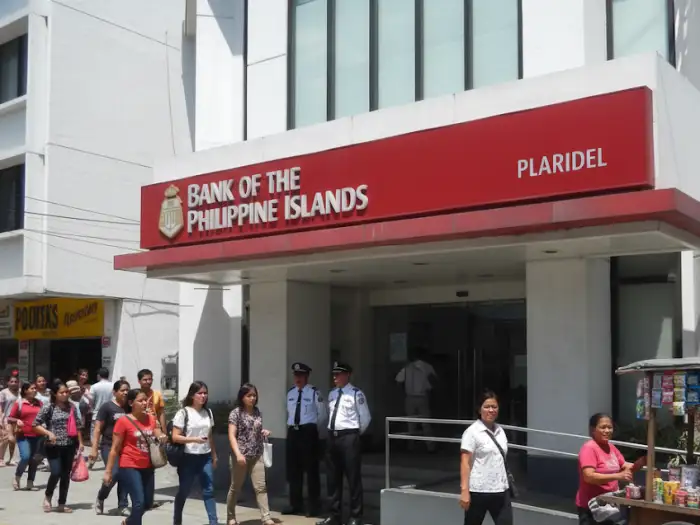
Bank of the Philippine Islands (BPI)
Founded in 1851, BPI is the oldest bank in the Philippines and one of the most respected. It has built its reputation on trust, innovation, and service reliability. BPI is widely chosen by professionals, students, and retirees for its balance of traditional branch banking and modern digital solutions. With its rebranded image and aggressive digital push, it appeals to customers who want a bank that is both established and forward-looking. However, BPI accounts can have stricter maintaining balances, and like most big banks, interest rates on regular savings accounts remain minimal.
Interest Rates & Account Types
- Regular Peso Savings: ~0.0625% to 0.125% annually.
- Maxi-Saver & Pamana Savings: Higher interest rates for bigger balances (up to ~0.375%).
- Time Deposits: 1.25–2.75% depending on term.
- Specialized accounts for kids, OFWs, and retirees available.
Initial Deposit & Maintaining Balance
- Opening Deposit: ₱3,000 for passbook, ₱1,000 for ATM-only savings.
- Maintaining Balance: ₱3,000 for passbook, ₱1,000 for ATM.
- Penalty Fees: ₱300/month if below maintaining balance; dormancy fee applies after 2 years.
Digital Banking & Accessibility
- BPI App & BPI Online: Widely praised for being one of the most user-friendly banking apps in the Philippines. Offers fund transfers, QR payments, bills payments, investments, and even insurance purchases.
- ATM Network: Over 3,000 ATMs nationwide plus partnerships with BancNet and Mastercard for global access.
- Online Transfers: Free InstaPay/PESONet promos at times, but usually has small transfer fees.
Safety & Insurance
- Deposits insured by PDIC up to ₱500,000 per depositor.
- Strong digital security with OTP, biometric login, and transaction alerts.
- Consistently high trust ratings for both retail and corporate accounts.
Best For
- Professionals and students who want modern digital banking with reliable service.
- Retirees and long-term savers looking for stability from one of the country’s oldest banks.
- Customers who want access to both savings and investment products in one ecosystem.
BPI Pros & Cons
Pros:
- Longstanding history and trusted reputation.
- Among the best digital banking apps in the Philippines.
- Wide range of products for different life stages.
Cons:
- Low interest rates for basic savings accounts.
- Maintaining balance requirements higher than digital banks.
- Occasional app downtime during system upgrades.
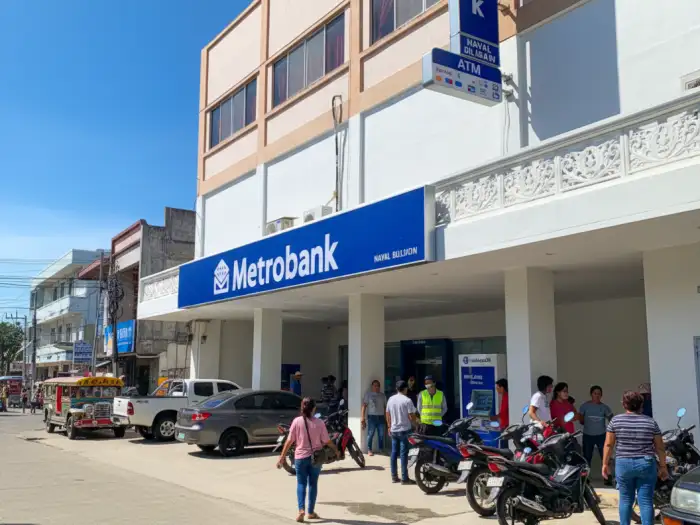
Metrobank
Metropolitan Bank & Trust Company (Metrobank) is one of the country’s most established universal banks, known for stability and premium banking services. With a wide presence of branches nationwide, it is especially trusted by professionals and business owners. Metrobank positions itself as a bank for financial growth – offering everything from regular savings to high-yield investment accounts, credit cards, and insurance. The downside: its requirements can feel stricter compared to other banks, and interest rates on regular savings remain modest.
Interest Rates & Account Types
- Regular Peso Savings Account: ~0.125% annually.
- Time Deposits: 1.25–2.75% depending on the term and deposit amount.
- Premium Accounts: Metrobank also offers high-tier accounts (like MetroDollar and Wealth Savings) for higher deposits.
Initial Deposit & Maintaining Balance
- Opening Deposit: ₱2,000 (ATM savings), ₱10,000 (Passbook savings).
- Maintaining Balance: ₱2,000–₱10,000 depending on the account type.
- Penalty Fees: Falling below maintaining balance can cost ~₱300/month; dormant accounts charged after 2 years of inactivity.
Digital Banking & Accessibility
- Metrobank Online App: Allows fund transfers, bills payments, QR transactions, time deposit placements, and investment account monitoring. Generally praised for its clean interface, though some users note occasional login issues.
- ATM Network: Thousands of ATMs across the country and international access via Mastercard.
- Online Transfers: Supports InstaPay and PESONet. Some transfer fees may apply.
Safety & Insurance
- All deposits insured by PDIC up to ₱500,000 per depositor.
- Offers biometric login and OTP security for transactions.
- Known for strong anti-fraud monitoring.
Best For
- Professionals and business owners looking for a stable, reputable bank with a full suite of services.
- Savers who prefer to grow into investments, insurance, and premium banking products.
Metrobank Pros & Cons
Pros:
- Longstanding reputation and financial stability.
- Clean, well-maintained branches with professional staff.
- Comprehensive financial ecosystem (loans, credit cards, investments, insurance).
Cons:
- Higher initial deposits and maintaining balance requirements.
- Regular savings interest rates are still low compared to digital banks.
- Customer service experiences vary depending on branch.
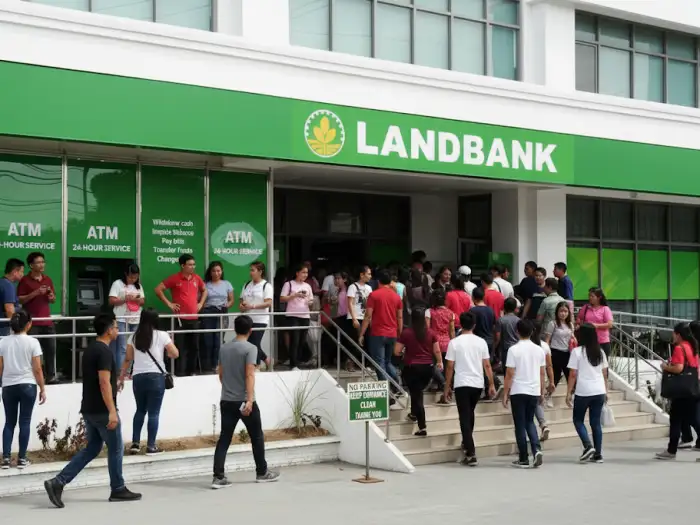
Land Bank of the Philippines (LANDBANK)
LANDBANK is a government-owned bank with a mandate to serve farmers, fisherfolk, cooperatives, and rural development projects – but it also functions as a universal bank for the general public. With branches in provinces where private banks may not operate, it plays a crucial role in financial inclusion. Many Filipinos choose LANDBANK for its accessibility in rural areas and its connection to government transactions (such as GSIS, Pag-IBIG, and SSS payouts). On the flip side, its digital services have historically lagged behind private banks, though recent improvements are bridging this gap.
Interest Rates & Account Types
- Regular Peso Savings Account: ~0.10% per year.
- Time Deposits: 1.25–2.75% depending on deposit amount and term.
- Special accounts for government workers, students, and cooperatives.
- Salary-linked accounts widely used for government employees.
Initial Deposit & Maintaining Balance
- Opening Deposit: ₱500–₱1,000 depending on the account type.
- Maintaining Balance: ₱500 for basic ATM savings; ₱1,000–₱2,000 for passbook savings.
- Penalty Fees: ₱200–₱300/month if below balance; dormancy fees apply after 2 years.
Digital Banking & Accessibility
- LANDBANK iAccess & Mobile App: Allows fund transfers, bills payment, and government-related transactions. The app has improved but still receives mixed reviews compared to private digital banks.
- ATM Network: Over 2,000 LANDBANK ATMs nationwide, many in provincial towns and municipalities where other banks have no presence.
- Online Transfers: Supports InstaPay and PESONet for interbank transfers.
Safety & Insurance
- Deposits insured by PDIC up to ₱500,000 per depositor.
- Uses OTP verification and email/SMS alerts for online transactions.
- As a government-owned bank, it has a strong guarantee of stability.
Best For
- Farmers, fisherfolk, and cooperatives needing financial services in rural areas.
- Government employees and retirees (GSIS/SSS) who rely on LANDBANK-linked accounts.
- Individuals in provinces where LANDBANK is the only accessible bank.
LandBank Pros & Cons
Pros:
- Strong government backing ensures stability.
- Branches in rural and underserved areas where private banks are absent.
- Widely used for government salaries, pensions, and loans.
Cons:
- Digital banking services less polished than private competitors.
- Customer service may be slow due to high transaction volumes.
- Savings interest rates are low compared to digital-only banks.
Top Digital Picks
SeaBank SeaBank, a subsidiary of the tech giant Sea Limited (parent company of Shopee), has quickly gained popularity by offering some of the most competitive interest rates on the market. Users are drawn to its straightforward value proposition: a high-yield savings account that credits interest daily. This allows savers to see their money grow in real-time, which is a powerful motivator. Its integration with Shopee also provides added convenience for online shoppers. The biggest pro is its market-leading interest rate, which can reach up to 6% per annum, coupled with free bank transfers via InstaPay and PESONet (up to a weekly limit). The cons include being a relatively new player in the market, which may concern more conservative depositors, and having a more limited product ecosystem compared to its digital peers.
Maya Bank Formerly known as PayMaya, Maya Bank has successfully evolved from a simple e-wallet into a full-fledged digital bank, offering an all-in-one financial app that is both powerful and intuitive. Users love its sleek, modern interface and the seamless integration of its wallet, savings, credit, and crypto features. The rewards system, which boosts savings interest rates based on app usage, gamifies the experience of managing finances and encourages users to transact more. Its pros are its excellent user experience, a comprehensive suite of in-app services, and an engaging rewards program. The primary con is that the tiered interest rate system can sometimes be confusing to track, and as with many feature-rich apps, some users have reported occasional bugs or glitches.
Tonik Bank Tonik burst onto the scene as the Philippines’ first licensed neobank, capturing attention with its unique and flexible savings products. It is particularly popular for its “Time Deposit” vaults, which allow users to lock in their savings for a set period to enjoy exceptionally high interest rates. Its “Stashes” feature, which helps users compartmentalize their savings for specific goals, is also a crowd favorite. People are drawn to Tonik’s fun, user-friendly branding and its innovative approach to saving. The pros are its highly competitive rates on time deposits and its goal-oriented savings tools. The main drawback is that its product offerings are more focused on savings, with fewer transactional features compared to competitors like Maya or GCash.
GCash GSave GCash GSave isn’t a standalone bank but rather a savings feature embedded within the nation’s most popular e-wallet, GCash. Its biggest advantage is its unparalleled convenience for the platform’s massive user base. For millions of Filipinos who already use GCash for daily transactions like paying bills, sending money, and buying load, opening a GSave account is an effortless next step. It is powered by partner banks like CIMB, which provides the attractive interest rates. The primary pro is its seamless integration into the GCash ecosystem, making saving incredibly accessible for everyday mobile users. The cons are that it is functionally a feature within another app, which might not appeal to those seeking a dedicated banking platform, and the user experience is dependent on the overall performance of the main GCash app.
📦 Table 2: Best Banks for Different Types of Savers (2025)
| Saver Type | Best Option | Why |
|---|---|---|
| Conservative Saver | BPI or Metrobank | Stability and trust |
| Government Employee | Landbank | Tailored to gov’t needs |
| Tech-Savvy Young Worker | SeaBank or Maya Bank | High rates and app ease |
| Discipline Builder | Tonik Bank | Lock-in vault feature |
| Everyday GCash User | GCash GSave | Easy to integrate into daily expenses |
💡Tips to Maximize Your Savings in 2025
Building savings isn’t just about choosing the right bank – it’s also about using smart habits and tools that make your money grow steadily. Here are practical ways to maximize your savings this year:
1. Automate your savings.
Set up scheduled transfers from your payroll account to your savings account every payday. This way, you “pay yourself first” before spending on wants. Automation removes the temptation to delay saving and ensures consistency.
2. Take advantage of lock-in features.
Many banks, especially digital ones, now offer lock-in savings or time deposit-like products. These prevent impulsive withdrawals and reward you with higher interest. Use them for medium-term goals like tuition, travel, or an emergency fund.
3. Diversify where you save.
Don’t put all your money in just one account. Keep a portion in traditional banks for security, easy access, and government transactions. Place another portion in digital banks or e-wallet-linked savings for higher interest rates and faster growth. Diversification balances safety and returns.
4. Always check PDIC coverage.
Before opening an account, make sure the bank is PDIC-insured (Philippine Deposit Insurance Corporation). This guarantees protection of up to ₱500,000 per depositor per bank, giving you peace of mind in case the institution faces issues.
5. Review and adjust regularly.
Your savings plan shouldn’t be static. Check your balances every few months and adjust your strategy if needed. As your income grows, increase your automated savings or explore higher-interest products.
6. Set clear goals.
Savings feel more rewarding when tied to a purpose – whether it’s an emergency fund, travel, education, or a future business. Goals keep you motivated and less likely to touch your money unnecessarily.
Frequently Asked Questions about Best Banks for Savings in the Philippines 2025
- What is the difference between traditional banks and digital banks when it comes to savings?
Traditional banks give you stability, a large branch/ATM network, and a familiar feel-but their interest rates are usually much lower (around 0.25–0.5%). Digital banks, on the other hand, are offering much higher rates (often 4-6%), faster account opening, and more flexible features-but sometimes with fewer physical touchpoints. - Are digital banks safe to use for my savings in 2025?
Yes, most of them are regulated by the Bangko Sentral ng Pilipinas (BSP) and insured by PDIC (up to certain amounts). But, since digital banks are newer, there’s still a risk of system downtimes, app glitches, or less established customer support. It helps to double-check if the bank is properly licensed before depositing large sums. - Which banks are best if I want a lot of branches and ATMs nearby?
Traditional banks like BDO, BPI, Metrobank, and Landbank still win in terms of physical presence. If you live outside Metro Manila or frequently deal with in-person transactions, one of these may offer more convenience. - What’s the highest savings interest rate I can realistically expect in 2025?
If you go for digital banks, rates of around 5-6% per annum are now being offered. Traditional banks are much lower. Sometimes digital banks also run promotions that temporarily boost rates-so it pays to watch out for those. - How much minimum deposit do I need for these savings accounts?
It depends: traditional banks often require minimums from ₱2,000 to ₱10,000. Many digital banks either have very low minimums or none at all. If you want to save with minimal upfront cost, go with a digital bank. - What are the trade-offs of choosing a high-interest digital savings account over a traditional one?
You’ll likely get better growth, flexibility, and convenience with digital banks. But you might lose out on in-person customer service, physical branches, or a full suite of banking products (loans, mortgages, etc.) Some digital banks also limit withdrawals or impose “lock-in” periods if you want the higher rate. - Which banks are best for different types of savers (e.g. conservative, tech-savvy, government employees)?
- Conservative savers often prefer BPI or Metrobank for trust and stability.
- Tech-savvy savers may lean toward SeaBank, Maya Bank, or Tonik because of high rates and digital tools.
- Government employees tend to favor Landbank because of its role in payrolls, pensions, and rural reach.
- Is it a good idea to spread my savings across more than one bank?
Yes, it’s a smart move. Splitting savings between traditional and digital banks gives you a balance: safety + accessibility from one bank, and higher growth from another. This also helps if one platform has downtime or issues. - What should I watch out for in the “terms & conditions” of savings accounts?
Important things: whether there’s a lock-in period for higher interest, how often interest is credited, maintaining balance fees, withdrawal limits, whether the bank has app downtime history, and whether the bank is properly insured. All these affect how much money you’ll actually earn in practice. - Can I use these high interest savings accounts if I’m sending money from abroad (OFW)?
Yes, many digital banks are becoming more OFW-friendly, but it depends. Traditional banks like BDO or BPI still have stronger remittance services and global infrastructure. If you send often and want growth, using a mix-remittance to a trusted bank + savings in a high-yield digital account-may be the best strategy.
✨ The Future of Saving in the Philippines
Choosing the best bank for savings in 2025 isn’t just about chasing the highest interest rates – it’s about balancing security, convenience, and growth. Traditional banks remain the bedrock of trust and stability, while digital banks represent the bold, exciting future of Philippine finance. For savvy Filipinos, the smartest move isn’t to pick one side but to use both strategically.
Imagine a Filipino worker: part of his savings sits in BPI, safe and stable, while another portion grows aggressively in SeaBank’s high-interest account. He has both security and growth, and he’s no longer dependent on just one institution. This hybrid approach reflects the financial future – diversified, digital, and disciplined.
The landscape of Philippine banking is changing fast. As inflation rises and technology advances, Filipinos must learn to adapt. Those who act early, choosing the right banks and building strong saving habits, will be the ones who thrive. The ₱100 you save today could be ₱200 tomorrow if placed in the right bank. And that’s the difference between financial stress and financial freedom.
So here’s the real challenge: don’t just pick a bank – pick a savings strategy. The future of your money isn’t just in where you keep it, but how you make it work for you. In 2025 and beyond, financial freedom belongs to those who plan, diversify, and stay committed.
🏦 References
-
FintechNews PH – Top 5 Banks With Best Deposit Interest Rates PH
-
RemoteStaff PH – Best Digital Banks in PH With High Interest
-
JuanInvestor – 11 Best Digital Banks in the Philippines 2025
-
Moneymax PH – Open a Savings Account Today: Top 10 Best Banks
-
Facebook Investagrams – Digital Banks Updated Interest Rates Sept 2025




